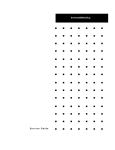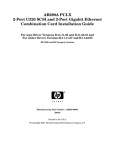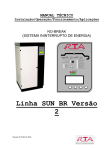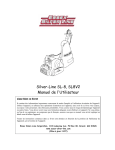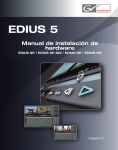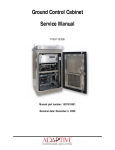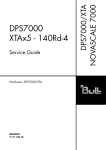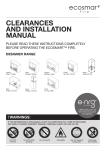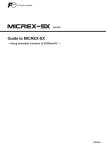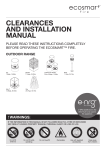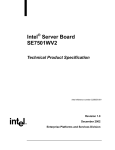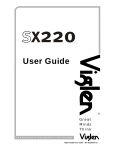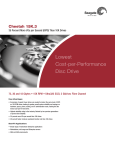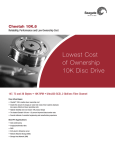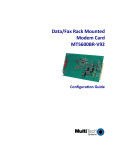Download NEC Express 120Mf User's Manual
Transcript
() Service Guide EXPRESS5800/120Mf ■ ■ ■ ■ ■ ■ ■ ■ ■ ■ ■ ■ ■ ■ ■ ■ ■ ■ ■ ■ ■ ■ ■ ■ ■ ■ ■ ■ ■ ■ ■ ■ ■ ■ ■ ■ ■ ■ ■ ■ ■ ■ ■ ■ ■ ■ ■ ■ ■ ■ ■ ■ ■ ■ ■ ■ ■ ■ ■ ■ ■ ■ ■ ■ ■ ■ ■ ■ ■ ■ ■ ■ ■ ■ ■ ■ ■ ■ ■ ■ ■ ■ ■ ■ ■ ■ ■ ■ ■ ■ ■ ■ ■ ■ ■ ■ ■ ■ iii CONTENTS Preface...........................................................................................................................................v Safety Indications .......................................................................................................................vi Notes on Using the Server.............................................................................................. 1-1 About Warning Labels ..................................................................................................................1-1 Safety Notes..................................................................................................................................1-2 General .....................................................................................................................................1-2 Power Supply and Power Code Use .........................................................................................1-3 Installation, Relocation, Storage, and Connection....................................................................1-5 Cleaning and Working with Internal Devices...........................................................................1-6 During Operation......................................................................................................................1-7 For Proper Operation ....................................................................................................................1-8 Transfer To Third Party.................................................................................................................1-9 NEC Express server ............................................................................................................1-9 Provided software ...............................................................................................................1-9 Disposal And Consumables ........................................................................................................1-10 Advice for Health..............................................................................................................1-11 User Support ...............................................................................................................................1-12 Overview........................................................................................................................... 2-1 Appearance ...................................................................................................................................2-1 Specifications................................................................................................................................2-2 Unit Configuration ........................................................................................................... 3-1 Specifications................................................................................................................................3-1 Names and Functions of Components ..........................................................................................3-3 Connector location........................................................................................................................3-3 Block diagram...............................................................................................................................3-3 Cable connection list.....................................................................................................................3-4 Troubleshooting............................................................................................................... 4-1 POST Error Message List .............................................................................................................4-1 Error Beep Codes..........................................................................................................................4-8 POST Codes..................................................................................................................................4-9 Preventive Maintenance.................................................................................................. 5-1 Periodic Maintenance ...................................................................................................................5-1 Maintenance by User ....................................................................................................................5-1 Installing Internal Optional Devices............................................................................... 6-1 Preparing for Installation and Removal ........................................................................................6-1 Power Supply Cage.......................................................................................................................6-2 Removing the Power supply unit (CAGE)..........................................................................6-2 Installing the Power supply unit (CAGE) ...........................................................................6-3 Fan Unit ........................................................................................................................................6-4 Removing the FAN unit ......................................................................................................6-4 Installing the FAN unit........................................................................................................6-4 Motherboard .................................................................................................................................6-5 Removing the Motherboard ................................................................................................6-5 Installing the New Motherboard .........................................................................................6-5 Making Backup Copies of NVRAM Information ...............................................................6-6 Restoring NVRAM Information .........................................................................................6-7 If the System is Unable to Make Backup Copies of NVRAM Information ........................6-9 iv Updating SDR FW ............................................................................................................6-11 Mounting a Heat Sink on the CPU....................................................................................6-11 Removing the Motherboard ..............................................................................................6-11 How to Attach the Motherboard....................................................................................... 6-14 SCSI Back Panel (SCSI-B.P) & SAF-TE Board........................................................................ 6-16 Removing the SCSI-B.P. .................................................................................................. 6-16 Installing the SCSI Back Panel ........................................................................................ 6-17 CD-ROM Drive ......................................................................................................................... 6-18 Removing the CD-ROM Drive ........................................................................................ 6-18 Floppy Disk Drive ..................................................................................................................... 6-19 Removing the FDD .......................................................................................................... 6-19 FRONT Bezel ............................................................................................................................ 6-20 Removing the Front Bezel................................................................................................ 6-20 Front Sub Bezel ......................................................................................................................... 6-21 Removing the Front Sub Bezel ........................................................................................ 6-21 Front Panel Board ...................................................................................................................... 6-22 Removing the Front Panel Board ..................................................................................... 6-22 Other Option Parts ..................................................................................................................... 6-23 Rack Mount Conversion ............................................................................................................ 6-23 Maintenance Parts ........................................................................................................... 7-1 Maintenance Parts List................................................................................................................. 7-1 Notes ................................................................................................................................. 8-1 About the Use of Screws.............................................................................................................. 8-1 About the Transporting ................................................................................................................ 8-1 Preface v Preface Welcome to the Express5800/120Mf server Service Guide. This manual describes the maintenance work necessary for the Express5800/120Mf basic processing unit. Keep this guide at hand for quick reference at any time it may be required. Read the section “Safety Indications” first, then proceed to “Notes On Using The Nec Express Server”. vi Preface Safety Indications Follow the instructions given in this service guide for proper operation and safe use of the NEC Express5800. This guide describes server components with possible danger, hazards that may be caused by ignoring warnings, and preventive actions against such hazards. Server components with possible danger are indicated with a warning label placed on or around them. They are also described in this guide. In the user’s guide and on warning labels, “WARNING” or “CAUTION” is used to indicate a degree of danger. These terms are defined as follows: WARNING CAUTION Indicates the presence of a hazard that may cause loss of life or serious personal injury if the instruction is ignored. Indicates the presence of a hazard that may cause minor personal injury, including burns or property damage, if the instruction is ignored. Precautions and notices against hazards are presented with one of the following 3 symbols. The individual symbols are defined as follows: This symbol indicates the presence of a hazard if the instruction is ignored. An image in the symbol illustrates the hazard type. (Attention) This symbol indicates prohibited actions. An image in the symbol illustrates a particular prohibited action. (Prohibited Action) This symbol indicates mandatory actions. An image in the symbol illustrates a mandatory action to avoid a particular hazard. (Mandatory Action) (Example) Symbol to draw attention Term indicating a degree of danger CAUTION Symbol indicating a prohibited action (may not always be indicated) Do not touch components in the NEC Express server while they are hot. Components (e.g., especially hard disk drive) in the server are hot immediately after the power is turned off. Mount/dismount components only when they are cool. Contents of a danger Chapter 1 Notes on Using the Server This chapter includes useful information for proper and safe operation of the NEC Express server. ABOUT WARNING LABELS The warning label is attached to components with possible danger or their vicinity in the NEC Express server to inform the user that a hazardous situation may arise when operating the server. (Do not take off any label or soil it.) If you find any label unattached, almost peeled off, or soiled, making the warning illegible, contact your sales agent. 1-2 Notes on Using the Server SAFETY NOTES This section provides notes on using the NEC Express server safely. Read this section carefully to ensure proper and safe use of the server. For symbols, see "SAFETY INDICATIONS" provided earlier. General WARNING Do not use the NEC Express server for services involving human lives or requiring high reliability. The NEC Express server is not intended to be used with or control facilities or devices concerning human lives, including medical devices, nuclear facilities and devices, aeronautics and space devices, transportation facilities and devices; and facilities and devices requiring high reliability. NEC assumes no liability for any accident resulting in personal injury, death, or property damage if the NEC Express server has been used in the above conditions. Do not use the NEC Express server if any smoke, odor, or noise is present. If smoke, odor, or noise is present, immediately turn off the POWER switch and disconnect the power plug from the outlet, then contact your sales agent. Using the server in such conditions may cause a fire. Keep needles or metal objects away from the NEC Express server. Do not insert needles or metal objects into ventilation holes in the NEC Express server or openings in the floppy disk or CD-ROM drive. Doing so may cause an electric shock. CAUTION Keep water or foreign matter away from the NEC Express server. Do not let any form of liquid (water etc.) or foreign matter (e.g., pins or paper clips) enter the NEC Express server. Failure to follow this warning may cause an electric shock, a fire, or a failure of the server. When such things accidentally enter the server, immediately turn off the power and disconnect the power plug from the outlet. Do not disassemble the server. Contact your sales agent. 1-3 Notes on Using the Server Power Supply and Power Code Use WARNING Do not hold the power plug with a wet hand. Do not disconnect/connect the plug while your hands are wet. Failure to follow this warning may cause an electric shock. Do not connect the ground wire to a gas pipe. Never connect the ground wire to a gas pipe. Failure to follow this warning may cause a gas explosion. CAUTION Plug in to a proper power source. Use a proper wall outlet. Use of an improper power source may cause a fire or a power leak. Do not install the NEC Express server where you need an extension cord. Use of a cord that does not meet the power specifications of the NEC Express server may heat up the cord and cause a fire. Do not connect the power cord to an outlet that has an illegal number of connections. The electric current exceeding the rated flow overheats the outlet, which may cause a fire. Insert the power plug into the outlet as far as it goes. Heat generation resulting from a halfway inserted power plug (imperfect contact) may cause a fire. Heat will also be generated if condensation is formed on dusty blades of the halfway inserted plug, increasing the possibility of fire. 1-4 Notes on Using the Server CAUTION Use the authorized power cord only. Use only the power cord that comes with the NEC Express server. Use of an unauthorized power cord may cause a fire when the electric current exceeds the rated flow. Also, observe the following to prevent an electric shock or fire caused by a damaged cord. • Do not stretch the cord harness. • Do not pinch the power cord. • Do not bend the power cord. • Keep chemicals away from the power cord. • Do not twist the power cord. • Do not place any object on the power cord. • Do not bundle power cords. • Do not alter, modify, or repair the power cord. • Do not secure the power cord with staples or equivalents. • Do not use any damaged power cord. (Replace a damaged power cord with a new one of the same specifications. Ask your sales agent for replacement.) 1-5 Notes on Using the Server Installation, Relocation, Storage, and Connection CAUTION Never attempt to lift the NEC Express server only by yourself. The NEC Express server weighs up to 44 kg (depending on its hardware configuration). Carrying the server only by yourself may strain your back. Hold the server firmly by its bottom with another person to carry it. Do not hold the front door to lift the server. The front door may be disengaged from the server, causing personal injury. Do not install the NEC Express server in any place other than specified. Do not install the NEC Express server in the following places or any place other than specified in this User's Guide. Failure to follow this instruction may cause a fire. ! a dusty place ! a humid place such as near a boiler ! a place exposed to direct sunlight ! an unstable place Do not connect any interface cable with the power cord of the NEC Express server plugged to a power source. Make sure to power off the NEC Express server and unplug the power cord from a power outlet before installing/removing any optional internal device or connecting/disconnecting any interface cable to/from the server. If the NEC Express server is off-powered but its power cord is plugged to a power source, touching an internal device, cable, or connector may cause an electric shock or a fire resulted from a short circuit. Do not use any unauthorized interface cable. Use only interface cables provided by NEC and locate a proper device and connector before connecting a cable. Using an authorized cable or connecting a cable to an improper destination may cause a short circuit, resulting in a fire. Also, observe the following notes on using and connecting an interface cable. ! Do not use any damaged cable connector. ! Do not step on the cable. ! Do not place any object on the cable. ! Do not use the NEC Express server with loose cable connections. 1-6 Notes on Using the Server Cleaning and Working with Internal Devices WARNING Do not disassemble, repair, or alter the NEC Express server. Never attempt to disassemble, repair, or alter the NEC Express server on any occasion other than described in this User's Guide. Failure to follow this instruction may cause an electric shock or fire as well as malfunctions of the server. Do not look into the CD-ROM drive A laser beam is used in the CD-ROM drive. Do not look into or insert a mirror into the drive while the drive is powered. If a laser beam is caught in your eyes, you may lose your eyesight (the laser beam is invisible). Do not remove the lithium battery. The NEC Express server contains a lithium battery. Do not remove the battery. Placing the lithium close to a fire or in the water may cause an explosion. When the server does not operate appropriately due to the dead lithium battery, contact your sales agent. Do not disassemble the server to replace or recharge the battery by yourself. Disconnect the power plug before cleaning the NEC Express server. Make sure to power off the NEC Express server and disconnect the power plug from a power outlet before cleaning or installing/removing internal optional devices. Touching any internal device of the NEC Express server with its power cord connected to a power source may cause an electric shock even of the NEC Express server is off-powered. Disconnect the power plug from the outlet occasionally and clean the plug with a dry cloth. Heat will be generated if condensation is formed on a dusty plug, which may cause a fire. CAUTION High temperature Immediately after the NEC Express server is powered off, its internal components such as hard disks are very hot. Leave the server until its internal components fully cool down before installing/removing any component. Make sure to complete board installation. Always install a board firmly. An incompletely installed board may cause a contact failure, resulting in smoking or fire. 1-7 Notes on Using the Server During Operation CAUTION Stay away from the fan. Keep your hand or hair away from the cooling fan on the rear of the NEC Express server. Failure to follow this warning may get your hand or hair caught in the fan, resulting in injury. Do not touch the NEC Express server when it thunders. Disconnect the power plug from the outlet when a thunderstorm is approaching. If it starts thundering before you disconnect the power plug, do not touch any part of the NEC Express server including the cables. Failure to follow this warning may cause a fire or an electric shock. Keep any animal (pet) away from the NEC Express server. Pet's discharges or fur may enter the NEC Express server and cause a fire or electric shock. Do not place any object on top of the NEC Express server. The NEC Express server may fall and cause property damage to the surroundings. Do not leave the NEC Express server with its CD-ROM tray ejected. Dust may enter the server through openings and cause malfunctions of the NEC Express server. Any person may also bump it and get injured. Take off the headset before connection. Make sure to take off the headset before plugging it to the headset jack. Failure to follow this instruction may hurt your ears. Make also sure to turn down the volume before connection. Do not use a cellular phone or pager around the NEC Express server. Turn off the cellular phone or pager. Radio interference may cause malfunctions of the NEC Express server. 1-8 Notes on Using the Server FOR PROPER OPERATION Observe the following notes for successful operation of the NEC Express server. Use of the NEC Express server ignoring the notes will cause malfunctions or failures of the server. ! Install the NEC Express server in a place that meets requirements for successful operation. For details, see Chapter 2, "Setting Up the Server." ! Do not delete the hard disk partition exclusively provided for maintenance of the NEC Express server although it may appear on the OS. ! Make sure to power off the NEC Express server before connecting or disconnecting cables between the server and peripheral devices. ! Verify that the access lamp on the NEC Express server is unlit before turning off the server or ejecting the floppy disk. ! Do not turn on the server after plugging the power cord. ! Do not turn off the server until the "NEC" logo and the some characters appear on the screen. ! When you have just turned off the NEC Express server, wait at least 30 seconds before turning it back on. ! Turn off the power and unplug the power cord from the outlet before relocating the NEC Express server. ! You may use a software command to eject the tray or a media from the CD-ROM drive or an optional device, for example a DAT, installed in the 5.25-inch device bay, respectively. Make sure that the front door is open before ejecting the tray or media with a software command. Running the command when the front door is closed will cause the tray or media to hit against the front door, which may cause a hardware failure of the NEC Express server as well as a software error. ! Clean the NEC Express server on a regular basis. (See Chapter 5 for cleaning.) Regular cleaning proactively prevents various failures of the server. ! Lightning may cause a momentary voltage drop. To prevent this problem, it is recommended to use an uninterruptible power supply unit. ! Make sure to use optional devices supported by the NEC Express server. Some non-supported devices may be physically installed/connected but cause failures of the server as well as a malfunction of the server. ! NEC recommends you use NEC's genuine products. Some third-party products claim that they support the NEC Express server. However, repair of the server due to a failure or damage resulted from use of such third-party products will be charged. 1-9 Notes on Using the Server TRANSFER TO THIRD PARTY The following must be observed when you transfer (or sell) the server or software provided with the server to a third party: NEC Express server Make sure to provide the User’s Guide along with the server to a third party. Provided software To transfer or sell any software application that comes with the NEC Express server to a third party, the following requirements must be satisfied: ! All provided software applications must be transferred and no backup copies must be retained. ! Transfer requirements listed in "Requirements for Software Use" that comes with each software application must be satisfied. ! Software applications that are not approved for transfer must be uninstalled before transferring the NEC Express server. 1-10 Notes on Using the Server DISPOSAL AND CONSUMABLES ! Dispose the server, hard disk drives, floppy disks, CD-ROMs, and optional boards as required by the local regulations. Ask your local government for details. IMPORTANT: For disposal (or replacement) of the battery on the motherboard of the NEC Express server, consult with your sales agent. ! The NEC Express server contains some components that are only good for a limited period of time and require replacement, such as fans, internal batteries, the internal CD-ROM drive, the floppy disk drive, and the mouse. For stable operation of the NEC Express server, NEC recommends you replace these components on a regular basis. Consult with your sales agent for replacement or the product lives. WARNING Do not remove the lithium battery. The NEC Express server contains the lithium battery. Do not remove the battery. Placing the lithium or nickel cadmium battery close to a fire or in the water may cause an explosion. When the server does not operate appropriately due to the dead lithium battery, contact your sales agent. Do not disassemble the server to replace or recharge the battery by yourself. Mother board 1-11 Notes on Using the Server Advice for Health The longer you keep using the computer equipment, the more you become tired, which may cause disorders of your body. When you use a computer, observe the following to keep yourself from getting tired: Good Working Posture You have good posture if the following are satisfied when you use a computer: • You sit on a chair with your back straight. • Your hands are parallel with the floor when you put them on the keyboard. • You look at the screen slightly lower than your eye height. You have "good working posture" as described in the above when no part of your body is under excess strain, in other words when your muscles are most relaxed. You have "bad posture" when you sit with your back hunched up or you operate a display unit with your face close to the screen. Bad working posture may cause eye strain or poor eyesight. Adjustment of Display Unit Angles Most display units are designed for adjustment of the horizontal and vertical angles. This adjustment is important to prevent the screen from reflecting bright lights and to make the display contents easy to see. You will not be able to keep "good working posture" and you will feel more tired than you should if you operate a display unit without adjusting horizontal and vertical angles. Adjustment of Screen Brightness and Contrast The display unit has brightness and contrast adjustment functions. The most suitable brightness and contrast depend on the individual and the working environment (well-lighted room or insufficient light). Adjust brightness and contrast so that the screen will be easy to see. An extremely bright or dark screen will give a bad effect to your eyes. Adjustment of Keyboard Angle The keyboard provided with the NEC Express server is designed for adjustment of an angle. Adjust the keyboard angle at which the keyboard is easy to operate. The adjustment assists in reducing strain on your shoulders, arms, and fingers. Cleaning of Equipment Clean equipment regularly. It is difficult to see the display contents on a dusty screen. Keeping equipment clean is also important for your sight. Fatigue and Rest If you feel tired, you should stop working and do light exercises. 1-12 Notes on Using the Server USER SUPPORT Before Asking for Repair, do the following when the NEC Express server appears to fail: 1. Check if the power cord and the cables to other devices are properly connected. 2. See Chapter 6 to find if your problem fits the description. recommended measure for it. 3. Check if the software required for operation of the NEC Express server is properly installed. If it does, take the If the NEC Express server still appears to fail after you have taken the above actions, consult with your sales agent immediately. Take notes on lamp indications of the server and alarm indications on the display unit before consultation, which may provide a significant help to your sales agent. Chapter 2 Overview This manual describes the maintenance method for NEC Express5800/120Mf basic processing unit. The explanation is for maintenance personnel who perform site adjustment, periodic inspection, and repair of NEC Express5800/120Mf basic processing unit. APPEARANCE External dimensions (WDH, mm) 321×675×450 Weight (kg : MAX) 23kg (Max 44kg) 2-2 Overview SPECIFICATIONS The table below lists the general specifications of the unit. Major Minor classification classification Input power Power supply Voltage Frequency Waveform distortion Power consumption Input current Apparent power Active power Temperature and Temperature humidity Humidity Noise POWER level Sound pressure level Standard Remarks Single phase, 2-pole grounding The power supply itself is capable between 100 100 to 240 VAC±10% to 240 VAC, however, 50±1 Hz or 60±1 Hz the value at the left is 10% used as a unit specification. 5.3 A AC100V 530 VA 520 W 10 to 35oC No condensation is allowed 20 to 80%RH 62.8 dB (operating) 60.9 dB (standby) 52.9 dB (operating) 51.7 dB (standby) Chapter 3 Unit Configuration SPECIFICATIONS 120Mf CPU Processor FSB Package L3 Cache Chipset Memory HDD Max. DIMM ECC Chipkill SpareMem Standard Max. HotPlug IDE I/F SCSI I/F DiskArray Non RAID RAID Internal Max. Ext. LAN Video (VRAM) Standard (x48/Half Height) 5.25” 3* (One for CDROM) 3.5” Standard: 5(1”) + Option 5(1”) Slot Total 6slots (64bit/133MHz PCI-X x1, 64bit /100MHz PCI-X x2, 32bit/33MHz PCI x3) I/O slot Hot Plug PCI Front I/O interface Rear Power Supply(PS) Redundant PS Redundant FAN Front Switch Rear Front door Key LED Front Rear Chassis (WxDxH) 2Way-Interleave 128/256/512MB/1GB DIMM *Online Spare memory Intel Alliance Carrier Ultra320,10K/15Krpm, SCA2 Standard: 5 slots Optional: 5 slots added HDD cage For CD-ROM/DVD-ROM/DVD-RAM On-Board (AIC7899W) LL MegaRAID On-Board, RemoteWakeUp On Board, RageXL 3.5" (2mode) x1 CD-ROM Device bay 512KB Grand Champion-LE(REV A3.1) 6GB (6 DIMMs) DDR266 SDRAM DIMM(Registered) Yes Yes Yes 0GB 10 x 146GB+ U320 10Krpm 36GB/73GB/146GB U320 15Krpm 36GB/73GB Yes Ultra ATA100 x1ch Ultra320 SCSI x2ch iROC Option 4 boards Option 10/100/1000BASE-T x2 640x480 ~ 1280x1024 (8MB) FDD Notes Prestonia x 1-2 533MHz FC-mPGA2 design Standard CDROM: *2 slots when rack conversion Max. 2HDD cages Ultra160 SCSI BP No Serial(DB9) x1*,USB x1 CRT x1, KB(PS/2) x1, Mouse(PS/2) x1, USB x3,Serial(DB9) x2*, Parallel x1, 1000BASE-T x2, Ultra320 SCSI x1, ICMB x2(PCI slot option) Hotswap 2+1 x 350W (PFC) Yes (option) Yes (standard) Power, Sleep, Reset, Dump No Yes Power/Sleep, System Status, HDD LAN Link/Act. x2, UID * Alternatively used 1 AC cable/1 Power Supply Hotswapable Hotswapable LAN Link/Act. X2, LAN Speed x2, UID Middle-Tower (321 x 675 x 450mm) Rack conversion(5U) 3-2 Unit Configuration NAMES AND FUNCTIONS OF COMPONENTS Please refer to the User’s Guide. CONNECTOR LOCATION Please refer to the User’s Guide. BLOCK DIAGRAM See next page. 3-3 Unit Configuration 3-4 Unit Configuration CABLE CONNECTION LIST Chapter 4 Troubleshooting If your NEC Express server does not operate as expected, read this chapter before assuming a failure. NOTE: Troubleshooting and POST error messages refer to User Guides. POST Error Message List On-screen error message Description Cause Action 0200 Failure Fixed Disk Hard disk failure 1. Incorrect setting in Setup 2. HDD failed 3. Motherboard failed 1. Check parameters entered in Setup 2. Replace HDD 3. Replace Motherboard 0210 Stuck Key Keyboard connection error Poor keyboard connection 0211 0212 Keyboard error Keyboard controller Failed Keyboard error Keyboard controller failure Keybord failed Keybord controller failed 0213 Keyboard locked Unlock key switch Monitor type does not match CMOS - Run SETUP Keyboard is locked. Keyboard is locked. 1. Disconnect and reconnect keyboard. 2. Replace keyboard 3. Replace Motherboard Check connection 1. Check connection 2. Re-Start 3. Replace Mother Board Release Keyboard lock System timer error Real time clock error A system timer error A real-time clock error 0220 0230 0231 0232 0250 0251 0252 0260 0270 The monitor type is not Incorrect monitor type 1. Reset default values in consistent with the setting Setup. CMOS data. 2. Clear CMOS DIMM failed 1. Replace DIMM System RAM Failed System RAM error. at offset 2. Replace Motherboard Shadow Ram Failed at Shadow RAM error. offset Extended RAM Failed Extended RAM error. at address line NV-RAM battery Replace Motherboard System battery is dead The system battery is - Replace and run worn out. SETUP NVRAM failed 1. Reset Setup parameters System CMOS The system CMOS checksum bad checksum is incorrect. 2. Replace Motherboard Default configuration used Password cleared Reset Setup parameters Password checksum The checksum of a bad - Passwords password is inaccurate. cleared Replace Motherboard RTC failed 4-2 Troubleshooting On-screen error message Description Cause Action 0271 Check data and time setting The real-time clock Unusual time setup of 1. Reset Setup parameters time setting is incorrect. RTC 2. Replace Motherboard 0280 Previous boot incomplete - Default configuration used Diskette drive A error Diskette drive B error Incorrect Drive A type - run SETUP Incorrect Drive B type – run SETUP System cache error Cache disabled System Memory exceeds the CPU's caching limit. EISA CMOS not write able DMA Test Failed Software NMI Failed The last boot is imperfect. Default value was set. Reset Setup parameters A floppy disk A error A floppy disk B error Incorrect drive A type FDD error Replace FDD Incorrect settings Reset Setup parameters 02B0 02B1 02B2 02B3 02D0 02D1 02F4 02F5 02F6 02F7 Fail-safe Timer NMI Failed 0611 IDE configuration changed 0612 IDE configuration error-device disabled 0613 COM A configuration changed 0614 COM A config. errordevice disabled 0615 COM B configuration changed 0616 COM B config. Errordevice disabled 0617 Floppy configuration changed 0618 Floppy config. error device disabled 0619 Parallel port configuration changed 061A Parallel port config. error - device disabled 0B00 Rebooted during BIOS boot at Post Code 0B01 Rebooted during OS boot. Incorrect drive B type A system cache error The memory exceeds the limit of the cache of CPU. It cannot write in EISA CMOS. DMA test error Software NMI error Fail-safe Timer error The composition error of IDE The composition device error of IDE The composition error of COM A The composition device error of COM A The composition error of COM B The composition device error of COM B The composition error of Floppy The composition device error of Floppy The composition error of Parallel port The composition device error of Parallel port The system re-started during BIOS boot The system re-started during OS boot 1. CPU failed 1. CPU Exchange 2. Motherboard failed 2. Replace Motherboard Motherboard failed Replace Motherboard 4-3 Troubleshooting On-screen error message 0B02 Rebooted during OS Runtime. 0B1B PCI System Error on Bus/Device/Function 0B1C PCI Parity Error on Bus/Device/Function 0B22 Processors are installed out of order. 0B28 Unsupported Processor detected on Processor 1 0B29 Unsupported Processor detect on Processor 2 0B30 Fan 1 Alarm occurred. 0B31 Fan 2 Alarm occurred. 0B32 Fan 3 Alarm occurred. 0B33 Fan 4 Alarm occurred. 0B34 Fan 5 Alarm occurred. 0B35 Fan 6 Alarm occurred. 0B50 CPU #1 with error taken off line 0B51 CPU #2 with error taken off line 0B5F Forced to use Processor with error 0B60 DIMM group #1 has been disabled 0B61 DIMM group #2 has been disabled 0B62 DIMM group #3 has been disabled 0B70 The error occurred during temperature sensor reading. 0B71 System Temperature out of the range. 0B74 The error occurred during voltage sensor reading. Description Cause Action Processor errors 1. Replace CPU 2. Replace Motherboard The system re-started during OS Running A PCI system error occurred on the bus, device, or function. A PCI parity error occurred on the bus, device, or function. Failure of a processor Unsupported processor mounted as processor 1. Unsupported processor mounted as processor 2. Fan errors 1. Fan is blocked 1. Check fan connection 2. Fan failed 2. Clean fan 3. Motherboard failed 3. Replace fan 4. Replace Motherboard CPU #1 was degraded due to an error detected for CPU #1. CPU #2 was degraded due to an error detected for CPU #1. A CPU error was detected. 1. CPU# 1 failed 1. Replace CPU #1 2. Motherboard failed 2. Replace Motherboard 1. CPU# 2 failed 1. Replace CPU #2 2. Motherboard failed 2. Replace Motherboard A memory error was detected. Memory #1 is degraded. A memory error was detected. Memory #2 is degraded. A memory error was detected. Memory #3 is degraded. An error was detected in 1. SMBus Device the course of thermal failed error detection. 2. SMBus Cable failed A thermal error was detected. An error occurred while Motherboard failed detecting the voltage. 1. Replace CPU 2. Replace Motherboard 1. Replace Memory #1 2. Replace Motherboard 1. Replace Memory #2 2. Replace Motherboard 1. Replace Memory #3 2. Replace Motherboard 1. Turn off AC 2. Check cable 3. Replace Motherboard 1. Clean fan 2. Replace fan 3. Replace boards 1. Turn off AC 2. Check connection of internal cables 4-4 Troubleshooting On-screen error message Description 0B75 System Voltage out of A system voltage error the range. was detected. Cause Action 1. SMBus Device failed 2. SMBus Cable failed 1. SMBus Device failed 2. SMBus Cable failed internal cables 3. Replace internal cables 4. Replace boards 0B78 The error occurred during fan sensor reading. 0B7C The error occurred during redundant power module confirmation. An error was detected during fan sensor reading. The error was detected while having constituted the redundant power supply. 0B7D The normal operation can't be guaranteed with use of only one PSU. 0B80 BMC Memory Test Failed. 0B81 BMC Firmware Code Area CRC check failed. 0B82 BMC core hardware failure. 0B83 BMC IBF or OBF check failed. Power supply error Basic power supply composition required for this equipment is not filled. BMC failed A BMC device (chip) failure 0B8A BMC SEL area full. An opening is not in the capacity of SEL. BMC check was interrupted temporarily. BMC command access failed. Console redirection cannot be carried out (BMC Busy) Console redirection cannot be carried out (BMC error) Console redirection cannot be carried out (BMC Parameter error) BMC failed A BMC device (chip) failure 0B8B BMC progress check timeout. 0B8C BMC command access failed. 0B8D Could not redirect the console - BMC Busy 0B8E Could not redirect the console - BMC Error 0B8F Could not redirect the console - BMC Parameter Error 0B90 BMC Platform Information Area corrupted. Replace a power supply 1. Turn off AC and re-start 2. Replace Motherboard Access to the BMC address failed. 0B91 BMC update firmware corrupted. 0B92 Internal Use Area of BMC FRU corrupted 1. Turn off AC 2. Check cable 3. Replace Motherboard An error of the SROM that stores the chassis information 0B93 BMC SDR Repository A BMC device (chip) empty. failure 1. SROM failed 2. BMC failed BMC failed 1. Turn off AC and re-start 2. Replace Motherboard 4-5 Troubleshooting On-screen error message Description Cause Action BMC failed 1. Turn off AC and re-start 2. Replace Motherboard Turn off AC and replace CPU#1 1. Turn off AC and re-start 2. Replace boards 0B94 IPMB signal lines do not respond. An SMC (Sattelite Management Controller) error 0B95 BMC FRU device An error of the SROM failure. that stores the chassis information 0B96 BMC SDR Repository The access error to failure. FMEM sector in which SDR information was stored 0B97 BMC SEL device A BMC device (chip) failure. failure 0B98 BMC RAM test error. 0B99 BMC Fatal hardware error. 0B9A Management controller not responding 0B9B Private I2C bus not responding. 0B9C BMC internal exception 0B9D BMC A/D timeout error. 0B9E SDR repository corrupt. 0B9F SEL corrupt. 0BB0 SMBIOS - SROM data read error. 0BB1 SMBIOS - SROM data checksum bad. 0BC0 POST detected startup failure of 1st Processor. 0BC1 POST detected startup failure of 2nd Processor. 0BD0 1st SMBus device address not acknowledged. 0BD1 1st SMBus device Error detected. 0BD2 1st SMBus timeout. BMC RAM error BMC error BMC error It-less answers from private I2 C bus BMC error BMC error The error of BMC or the data of SEL is destroyed. The error of BMC or the data of SEL is destroyed. Incorrect SROM data read Incorrect SROM data checksum Processor 1 error Turn off AC and replace CPU#1 Processor 2 error Turn off AC and replace CPU#2 A device-less answers to 1st SMBus access. The error was detected to 1st SMBus access The timeout occurred to 1st SMBus access. SMBus Access error 1. Turn off AC and re-start 2. Replace boards 3. Replace internal cables 4-6 Troubleshooting On-screen error message 0BD3 2nd SMBus device address not acknowledged. 0BD4 2nd SMBus device Error detected. 0BD5 2nd SMBus timeout. 0BD6 3rd SMBus device address not acknowledged. 0BD7 3rd SMBus device Error detected. 0BD8 3rd SMBus timeout. 0BD9 4th SMBus device address not acknowledged. 0BDA 4th SMBus device Error detected. 0BDB 4th SMBus timeout. 0BDC 5th SMBus device address not acknowledged. 0BDD 5th SMBus device Error detected. 0BDE 5th SMBus timeout. 0BE8 IPMB device address not acknowledged. 0BE9 IPMB device Error detected. 0BEA IPMB timeout. 8100 8101 8102 8120 8121 Memory Error detected in DIMM group #1 Memory Error detected in DIMM group #2 Memory Error detected in DIMM group #3 Unsupported DIMM detected in DIMM group #1 Unsupported DIMM detected in DIMM group #2 Description Cause Action A device-less answers to 2nd SMBus access. The error was detected to 2nd SMBus access The timeout occurred to 2nd SMBus access. A device-less answers to 3rd SMBus access. The error was detected to 3rd SMBus access The timeout occurred to 3rd SMBus access. A device-less answers to 4th SMBus access. The error was detected to 4th SMBus access The timeout occurred to 4th SMBus access. A device-less answers to 5th SMBus access. The error was detected to 5th SMBus access The timeout occurred to 5th SMBus access. A device-less answers IPMB Access error to IPMB access The error was detected to IPMB access The timeout occurred to IPMB access. DIMM error A memory error was detected. Unsupported DIMM was detected. Replace two DIMMs. 4-7 Troubleshooting On-screen error message 8122 8130 8131 8132 8140 8141 8142 8150 8160 8161 Unsupported DIMM detected in DIMM group #3 Mismatch DIMM Type detected in DIMM group #1. Mismatch DIMM Type detected in DIMM group #2. Mismatch DIMM Type detected in DIMM group #3. DIMM group #1 with error is enabled. DIMM group #2 with error is enabled. DIMM group #3 with error is enabled. NVRAM Cleared By Jumper Mismatch Processor Speed detected on Processor 1 Mismatch Processor Speed detected on Processor 2 Description Cause Action The type of DIMM is not in agreement. 1. Check that DIMMs of the same type are installed in groups. 2. Replace DIMMs. Failed DIMM in group #1 was detected. Failed DIMM in group #2 was detected. Failed DIMM in group #3 was detected. NVRAM was cleared by jumper setup. Replace both DIMMs. The frequency of processor 1 is not correct. The frequency of processor 2 is not correct. Incorrect jumper setting Processor errors Turn off power and change the jumper setting back to its default position. 4-8 Troubleshooting Error Beep Codes Beep 1-2-2-3 1-3-1-1 1-3-1-3 Error ROM checksum error DRAM refresh test error Keyboard controller error 1-3-3-1 DIMM can not be detected 1-3-3-1 1-3-4-3 Memory check error DRAM test low byte error 2-2-3-1 Unjust exception test error 1-2 Video configuration fails 1-2 OPTION ROM Checksum failure Cause FMEM checksum error Memory refresh error Keyboard controller error Memory not installed or cannot write. ↑ Memory address signal fault (low side) Unjust exception Expansion VGA BIOS memory Deployment failure Expansion ROM BIOS memory Deployment failure Troubleshooting Replace MotherBoard Replace DIMM Replace MotherBoard Check DIMM Mounting or Replace DIMM ↑ Replace MotherBoard or DIMM Replace MotherBoard or CPU Replace MotherBoard or Graphic board Replace MotherBoard or Option board 4-9 Troubleshooting POST Codes The code displayed using the postcard is shown below. CP 01 02 03 04 06 08 09 0A 0B 0C 0E 0F 10 11 12 13 14 16 17 18 1A 1C 20 22 24 28 29 2A 2C 2E 2F 32 33 34 35 36 37 38 39 3A 3C 3D 41 40 42 Reason Initialize BMC Verify Real Mode Test BMC Get Processor type Initialize system hardware Initialize chipset registers with initial POST values Set in POST flag Initialize Processor registers Enable Processor cache Initialize caches to initial POST values Initialize I/O Initialize the local bus IDE Initialize Power Management Load alternate registers with initial POST values Restore Processor control word during warm boot Initialize PCI Bus mastering devices Initialize keyboard controller BIOS ROM checksum Initialize external cache before memory autosize 8254 timer initialization 8237 DMA controller initialization Reset Programmable Interrupt Controller Test DRAM refresh Test 8742 Keyboard Controller Set ES segment register to 4GB Autosize DRAM, system BIOS stops execution here if the BIOS does not detect any usable memory DIMMs Initializes the POST Memory Manager Clear 8 MB base RAM Base RAM failure, BIOS stops execution here if entire memory is bad Test the first 4MB of RAM Initialize external cache before shadowing Test Processor bus-clock frequency Initializes the Phoenix Dispatch Manager Test CMOS RAM Initialize alternate chipset registers Warm start shut down Reinitialize the chipset Shadow system BIOS ROM Reinitialize the cache Autosize cache Configure advanced chipset registers Load alternate registers with CMOS values Check unsupported processor Set Initial Processor speed new Initialize interrupt vectors 4-10 Troubleshooting CP 44 45 46 47 48 49 4A 4B 4C 4E 4F 50 52 54 55 56 58 59 5A 5B 5C 60 62 64 66 67 68 69 6A 6B 6C 6E 70 72 74 76 7A 7C 7D 7E 81 82 83 84 85 86 87 88 89 Reason Initialize BIOS interrupts POST device initialization Check ROM copyright notice Initialize manager for PCI Option ROMs Check video configuration against CMOS Initialize PCI bus and devices Initialize all video adapters in system Display QuietBoot screen Shadow video BIOS ROM Display copyright notice Allocate memory for the multiboot data Display Processor type and speed Test keyboard Set key click if enabled USB initialization Enable keyboard Test for unexpected interrupts Initialize the POST display service Display prompt “Press F2 to enter SETUP” Disable L1 cache during POST Test RAM between 512 and 640k Test extended memory Test extended memory address lines Jump to UserPatch1 Configure advanced cache registers Quick init of all AP's early in post Enable external and processor caches Initialize the SMM handler Display external cache size Load custom defaults if required Display shadow message Display non-disposable segments Display error messages Check for configuration errors Test real-time clock Check for keyboard errors Test for key lock on Set up hardware interrupt vectors Intelligent system monitoring Test coprocessor if present POST device initialization routine Detect and install external RS232 ports Configure non-MCD IDE controllers Initialize parallel ports Initialize PC-compatible PnP ISA devices Re-initialize on board I/O ports Configure Mother Board Configurable Devices Initialize BIOS Data Area Enable Non-Maskable Interrupts 4-11 Troubleshooting CP 8A 8B 8C 90 91 92 93 94 95 96 97 98 99 9A 9C 9D 9E A0 A2 A4 A8 A9 AA AC AE B0 B2 B4 B5 B6 B7 B9 BA BC BD BE C0 C1 C2 C3 C6 C7 CD D1 D3 Reason Initialize Extended BIOS Data Area Test and initialize PS/S mouse Initialize floppy controller Initialize hard disk controller Initialize local bus hard disk controller Jump to UserPatch2 Build MPTABLE for multi-processor boards Disable A20 address line Install CD-ROM for boot Clear huge ES segment register Fixup Multi Processor table Search for option ROMs. One long, two short beeps on checksum failure Check for SMART Drive Shadow option ROMs Set up Power Management Initialize security engine Enable hardware interrupts Set time of day Check key lock Initialize typematic rate Erase F2 prompt Prepare boot Scan for F2 key stroke Print bottom message Clear the POST flag Check POST Error POST End Beep once End the Quiet Boot Check Password Configuration ACPI Prepare boot DMI Configuration Clear parity checkers Display Boot Menu Clear Screen INT19 Initialize the POST Error Manager Invoke End of POST Error Logging Invoke End of POST Error Message Display Initialize Console Redirection Control Console Port Initialize Console Redirection Initialize BIOS stack Find an A20-agnostic place in memory 4-12 Troubleshooting Chapter 5 Preventive Maintenance PERIODIC MAINTENANCE The following items are to be periodically maintained every 6 months. No. Check Item Site Frequency Regular Daily 1 Cleaning of FDD head 2 Check fan operation ○ ○ 3 Check T&D operation ○ ○ 4 5 Check date and time of internal clock Check UPS battery ○ ○ 6 Cleaning of CD-ROM head ○ ○ ○ 7 Check switches ○ ○ ○ Remarks ○ ○ Clean it at the same time. ○ Clean options such as DAT. Check smoothness. * If any option is added, follow the instructions for that option. MAINTENANCE BY USER Request the user for maintenance of the following items. No. 1 2 3 4 Item Confirm date and time of the internal clock Check test programs Execution of test program at failure, and collection of error data Cleaning of head and running section of CD-ROM and DAT Frequency Remarks At restart of the system after holidays. At site adjustment At error occurrence At regular check At error occurrence Once a day According to the instruction manual 5-2 Preventive Maintenance Chapter 6 Installing Internal Optional Devices PREPARING FOR INSTALLATION AND REMOVAL Follow the procedure below to prepare for installing or removing components. a. Shut down the OS. b. Press the POWER switch to power off the NEC Express server (the POWER lamp goes off). c. Unplug the power cord of the NEC Express server from a power outlet. The power cord appended to the server as standard. The power cord appended to the extension power unit. d. Remove all cables from the rear of the NEC Express server. e. A clearance of one to two meters must be provided around and over the NEC Express server. 6-2 Installing Optional Internal Devices POWER SUPPLY CAGE Removing the Power supply unit (CAGE) a. See the section “Preparing for Installation and Removal” described earlier to prepare. b. Remove the left side cover c. Remove all power cables from the motherboard, 5.25-inch devices, floppy drive and SCSI-BP. NOTE: Make sure not to hitch the cable when pulling out the Power supply unit. d. Remove the two screws on the rear side. screws e. Remove the two screws on the front side. f. Pull out the Power cage gently away from the server chassis. # Be careful not to force the cage out of the server or not to hook a cable. 6-3 Installing Optional Internal Devices Installing the Power supply unit (CAGE) Follow the removal procedure in reverse order to install the Power supply unit. 6-4 Installing Optional Internal Devices FAN UNIT Removing the FAN unit <HDD FAN UNIT> a. See the section “Preparing for Installation and Removal” described earlier to prepare. b. Remove the left side cover. c. Remove the FAN cover (foaming material: gray color). d. Remove the FAN DC cable from the Motherboard, and pull out the FAN unit. <REAR FAN UNIT> a. See the section “Preparing for Installation and Removal” described earlier to prepare. b. Remove the left side cover. c. Remove the FAN DC cable from the Motherboard. d. Remove the lock of the rear fan unit. Pull out the FAN unit. Lock Installing the FAN unit Follow the removal procedure in reverse order to install the FAN unit. 6-5 Installing Optional Internal Devices MOTHERBOARD Removing the Motherboard * After replacing the motherboard, you need to re-set the NvRAM information and SDR FW on the new motherboard. Make backup copies of the current NvRAM information before replacing the motherboard, and restore the information onto the new motherboard after the replacement. For details, see "Management of Setup Information." If the system is unable to make backup copies, set the NvRAM information. a. See the section “Preparing for Installation and Removal” described earlier to prepare. b. Remove the left side cover c. Take out the DIMM boards, PCI boards and cables. d. Remove the screws securing the Motherboard. e. Take out the Motherboard carefully to avoid any damage. Installing the New Motherboard Follow the removal procedure in the reverse order to mount the new motherboard. Note the following points in mounting it: 1) Confirm that all the cables are connected correctly, no wire is caught, and all the connectors are connected correctly. 2) Do not bend the springs and gaskets for EMI prevention measures. 3) After mounting the new motherboard, connect the cables firmly by using clamps. 4) For mounting of the heat sink, see Section 5. 5) Mount the provided heat-conduction sheet between the CPU and the heat sink. Be careful not to bend the heat-conduction sheet when mounting it. 6-6 Installing Optional Internal Devices Making Backup Copies of NVRAM Information a. Set the NEC EXPRESSBUILDER CD-ROM in the CD-ROM drive, and activate the NEC EXPRESSBUILDER. b. When the NEC EXPRESSBUILDER becomes active, activate the Offline Maintenance utility by selecting "Tool" from the menu → "Offline Maintenance Utility" → " Manage System Information". c. When the Offline Maintenance utility becomes active, select "Save" from the menu. After that, a message is displayed "asking if you want to format the floppy disk." Respond to the message to format the floppy disk if necessary. The data backup confirmation screen appears after the format confirmation screen. Press the "Enter" key to perform backup processing. (Screen image) Offline Maintenance Utility Edit/Display HW Logs Edit/Display SW Logs Edit/Display HW Event Logs Display BIOS Setup Information Display System Information Manage System Information Set Remote Maintenance Information Help Exit Manage System Information Save Menu for Maintenance Persons Exit 6-7 Installing Optional Internal Devices Restoring NVRAM Information a. Set the NEC EXPRESSBUILDER CD-ROM in the CD-ROM drive, and activate the NEC EXPRESSBUILDER. b. When the NEC EXPRESSBUILDER becomes active, activate the Offline Maintenance utility by selecting "Tool" from the menu → "Offline Maintenance Utility" → " Manage System Information." c. When the Offline Maintenance utility becomes active, select "Menu for Maintenance Persons" from the menu. (Screen image) Offline Maintenance Utility Edit/Display HW Logs Edit/Display SW Logs Edit/Display HW Event Logs Display BIOS Setup Information Display System Information Manage System Information Set Remote Maintenance Information Help Exit Manage System Information Save Menu for Maintenance Persons Exit d. Do not care about a notice displayed, and press the Enter key. enter the password. Enter the password as shown below. The system asks you to Password >CENVRAM e. Select restoration of the old board information when the following screen appears after you enter the password: Menu for Maintenance Persons Restore (at replacement of the mother board) Update Product/Cabinet Information Return to the Previous Menu 6-8 Installing Optional Internal Devices f. When the "Restore (at replacement of the mother board)" screen appears, insert the floppy disk containing the backup copies of the NVRAM information into the floppy disk drive, and press the Enter key. (The following is an image screen, which may be different from the actual one.) Restore (at replacement of the mother board) Data Name BIOS Information 1 BIOS Information 2 Maintenance Utility Information BMC Information 1 BMC Information 2 BMC Information 3 ROM Pilot Information 1 ROM Pilot Information 2 Product Information Cabinet Information Internal useara Device Address Size -------- -------- --------------- -------- --------------- -------- --------------- -------- --------------- -------- --------------- -------- --------------- -------- --------------- -------- --------------- -------- --------------- -------- --------------- -------- -------- File Name ------------------------------------------------------------------------------ Setup O O O O O O O O O O O Start restoration (Data with a circle shown in the column "Setup" is restored.) Exit: g. [ESC] Press the Enter key when the following confirmation screen appears. After that, the NVRAM information is loaded from the floppy disk. Restore (at replacement of the mother board) The restore processing is in progress. Wait until the processing is completed. Execute: [Enter] h. Cancel: [ESC] The screen displays restoration results as shown below. (The following is an image screen, which may be different from the actual one.) Restore (at replacement of the mother board): Data Name BIOS Information 1 BIOS Information 2 Maintenance Utility Information BMC Information 1 BMC Information 2 BMC Information 3 ROM Pilot Information 1 ROM Pilot Information 2 Product Information Cabinet Information Internal useara Exit: i. Device ------------------------------------------------------------------------------ Address ------------------------------------------------------------------------------ Execution results = normal Size File Name Setup Result --------------O O --------------O O --------------O O --------------O O --------------O O --------------O O --------------O O --------------O O --------------O O --------------O O --------------O O [ESC] Terminate the Offline Maintenance utility when the NVRAM information has been loaded from the floppy disk. 6-9 Installing Optional Internal Devices If the System is Unable to Make Backup Copies of NVRAM Information Set the NVRAM information on the new motherboard by taking the following steps. a. Set the NEC EXPRESSBUILDER CD-ROM in the CD-ROM drive, and activate the NEC EXPRESSBUILDER. b. When the NEC EXPRESSBUILDER becomes active, activate the Offline Maintenance utility by selecting "Tool" from the menu → "Offline Maintenance Utility" → "Manage System Information." c. When the Offline Maintenance utility becomes active, select "Menu for Maintenance Persons" from the menu. (Screen image) Offline Maintenance Utility Offline Maintenance Utility Manage System Information Execute the Offline Maintenance Utility Set Remote Maintenance Information Return to the Custom Setup Menu ⇓ Manage System Information Save Menu for Maintenance Persons Exit d. Do not care about a notice displayed, and press the Enter key. enter the password. Enter the password as shown below. The system asks you to Password >CENVRAM e. Select "Update Product/Cabinet Information" when the following screen appears after you enter the password: Menu for Maintenance Persons Restore (at replacement of the mother board) Update Product/Cabinet Information Return to the Previous Menu f. The screen shown below appears. Enter key. Move the cursor to "Set Default Values" and press the 6-10 Installing Optional Internal Devices Update Product/Cabinet Information Data Name Manufacturer (Manufacturer Name) Model Name (Product Name) N Code (Product Part) FR Number (Product Version) Serial Number (Product Serial) Cabinet Information Set Default Values Update g. The device type list is displayed. Set Value NEC NEC Express5800/1**** (*: Model name) [N8100-***] FR*.* 0000*** Select the target device type. (If the target device type is not in the list, select an arbitrary device type.) h. The screen in step 6 is displayed again. device. Correct the values according to the selected The following must be changed: • FR Number • Serial Number Cabinet information: Model 120Me i. Cabinet type Cabinet model number Cabinet ID Cabinet attribute 07 856-060230-001-00 05 06 Return to the screen in step 6, move the cursor to "Update," and press the Enter key. When the confirmation screen shown below appears, press the Enter key again. Update Product/Cabinet Information Do you want to update the product/cabinet information? Execute: [Enter] Cancel: [ESC] When the update processing terminates normally, terminate the NEC EXPRESSBUILDER according to the instructions displayed on the screen, and confirm that the device starts up normally. j. When the NEC Logo screen appears during device startup, press the "F2" key to activate the BIOS SETUP menu, and set the previously set information again. 6-11 Installing Optional Internal Devices Updating SDR FW Refer to the update procedure document of the Motherboard maintenance parts. Mounting a Heat Sink on the CPU Refer to the Express Server User’s guide. Removing the Motherboard a. b. c. Turn off the power, and then pull the AC cable out. Remove a side cover. Extract heat sinks, CPUs, memory boards, PCI boards, etc. The following procedure explains how to remove a heat sink. (Please DO NOT pull up straight to draw out a heat sink. If it is removed that way, CPU may be taken out with heat sink. ) 1. When removing retention, use a minus driver or the tool only for removal of a clip, hook on a hole and remove. 2. Remove the retention. 3. Please turn the heat sink to the right and left lightly to remove it. Please DO NOT pull up straight. To remove a CPU, follow the procedure for installing a heat sink in reverse order. 6-12 Installing Optional Internal Devices d. Remove the screws fixing the Motherboard. Remove R / M fixed screws as well. e. Take out the Motherboard carefully so as to avoid damaging it. Be sure to respect the specified order when removing components When you remove a motherboard, first remove CPUs and heat sinks (a total of eight screws) before removing retention modules. Refer to the following page. 6-13 Installing Optional Internal Devices CPU socket Retention module Retention module CPU socket <Caution> When attaching a Heat sink to the newly installed motherboard, please use the new cool sheet appended to mother board set. Moreover, please remove the old cool sheet of the heat sink with a driver etc. Heat Sink Please remove the old cool sheet of the heat sink with a driver etc. 6-14 Installing Optional Internal Devices How to Attach the Motherboard To attach the motherboard, follow the removal procedure in the reverse order. Be careful of the following points. a. Check cables, confirm that wires are not pressed, install all connectors, etc. b. Do not bend the spring for EMI and a gasket. c. Use clamps to connect cables after Motherboard is installed. d. Follow the instructions below to attach a Heat Sink The Retention module can be removed by using a minus driver or the removing clip tool. Socket with dust cover (sponge) removed Lever 1. Pull up the lever. 2. Install a processor. 3. Push the lever back down and fix a processor. 6-15 Installing Optional Internal Devices 4. Position the heat sink on the processor and hook it on one side of the retention module. 5. Fix the other side of retention module. * Caution When removing the retention, hook the hole (designated by the arrow on the picture left) using a thin minus driver or a tool. 6-16 Installing Optional Internal Devices SCSI BACK PANEL (SCSI-B.P) & SAF-TE BOARD Removing the SCSI-B.P. a. See the section "Preparing for Installation and Removal" described earlier to prepare. b. Pull out all hard disks. c. Remove the left side cover. d. Remove the cable for SCSI-B.P. e. Remove five screws and pull out the disk cage gently away from the server chassis. 6-17 Installing Optional Internal Devices f. Remove four screws, and remove the SCSI-B.P. (with SAF-TE board) gently away from the disk cage. SAF-TE board SCSI-B.P Installing the SCSI Back Panel Follow the removal procedure in reverse order to install the SCSI Back Panel. 6-18 Installing Optional Internal Devices CD-ROM DRIVE Removing the CD-ROM Drive a. See the section "Preparing for Installation and Removal" described earlier to prepare. b. Remove the left side cover. c. Remove all cables connected to the CD-ROM drive. d. Remove four screws in front of the case, and pull out the CD-ROM bracket gently away from the server. e. Remove all screws on the side of the CD-ROM drive. 6-19 Installing Optional Internal Devices FLOPPY DISK DRIVE Removing the FDD a. See the section "Preparing for Installation and Removal" described earlier to prepare. b. Remove the left side cover. c. Remove all cables connected to the FDD. d. Remove two screws in front of the case, and pull out the CD-ROM bracket gently away from the server. e. Remove all screws from the FDD bracket. 6-20 Installing Optional Internal Devices FRONT BEZEL Removing the Front Bezel a. Open the front bezel. b. Use pliers to draw out the pins in the upper and lower corners on the right side of the server. 6-21 Installing Optional Internal Devices FRONT SUB BEZEL Removing the Front Sub Bezel a. See the section "Preparing for Installation and Removal" described earlier to prepare. b. Remove the left side cover. c. Remove the lock of the front sub bezel. d. After shifting the front sub bezel up, pull it toward you and remove it. . Lock 6-22 Installing Optional Internal Devices FRONT PANEL BOARD Removing the Front Panel Board a. See the section "Preparing for Installation and Removal" described earlier to prepare. b. Remove the left side cover. c. Remove all cables on the front panel board. d. Remove the four screws on the front panel board. 6-23 Installing Optional Internal Devices OTHER OPTION PARTS Refer to the User’s Guide shipped with the option part or Basic Processing Unit. RACK MOUNT CONVERSION Express5800/120Mf can be converted to a rack mount system. Refer to the User’s Guide shipped with the server. 6-24 Installing Optional Internal Devices Chapter 7 Maintenance Parts MAINTENANCE PARTS LIST Maintenance parts are shown below. NEC PART DESCRIPTION COMMENTS NUMBER 6882580000 MBD ARIMA HODGES 120MF 6864890000 6865160100 MASTER KEY FOR 120LF & 120ME 120LF HS LVD SCSI CABLE 6865170000 120LF/120ME I2C CABLE 6842180100 120ME COM2 CABLE 6842170000 120LF INT SCSI CBL FOR DAT/DLT 6842200000 120LF FLOPPY CABLE 6865190000 120LF/120ME IDE CABLE 6842350100 INTRUS. SWITCH W/ BRKT & CBL 6847230100 HUDSON II-III RM KIT ENLIGHT 6862560000 120LF FRONT PANEL W/ CBL 6842270100 120LF FRONT PANEL BOARD RWK 120LF IFRONT PANEL USB CABLE 6842260000 6842300000 6865300000 120LF FRONT PANEL CABLE 120ME LEFT COVER ASSY 6865350000 120ME HOTSWAPP FAN ASSY 6865320000 120ME REAR FAN ASSY QTY = 2 6865330000 FRONT CPU & HDD CAGE1 FAN QTY = 1 6865340000 6865360000 FRONT PCI & HDD CAGE2 FAN CPU PCI DUCT & FAN HOLDER ASSY QTY = 2 6865370000 700W POWER SUPPLY CAGE 6869560000 FAN CBL ASSY 120ME 313-01517-000 REDUNDANT PSU 350W KIT 6842330000 120LF FRONT BEZEL 6842320000 120LF FRONT DOOR 6842340000 120LF TOWER FOOT 6786020200 FDD D353M3D R69-4010 W/FR BEZ 856-850222-001A CDROM DRIVE MITSUMI FX-4840W 245-01508-000 ADDIT. FIVE DISK HS HDD CAGE 245-01509-000 INTEL ALLIANCE HDD HS CARRIER 320-015010000 HD SCSI ACTIVITY LED CBL 460MM 6884920000 6884930000 XEON 2.0 GHZ/533/512 C1 SL6RQ XEON 2.8GHZ/533/512 C1 SL6GG 6884940000 XEON 2.4GHZ/533MHZ512 C1 SL6MY 6889470000 XEON 2.66GHZ/533/512 SL6GF 6887430000 HEATSINK CLIP P533 QTY = 2 / heatsink 6867350000 CPU RETENTION MODULE FOXCONN QTY = 2 / heatsink 309-01530-000 FOSTER/PRESTONIA HEATSINK 6863170000 MEM 128MB M383L1713DTS-CBO 7-2 Maintenance Parts 6874140000 MEM 256MB M383L3223DTS-CB0 6874130000 MEM 1GB DDR SDRAM 266MHZ 6874120000 MEM 512MB M383L6420DTS-CB0 6893340000 HDD 18G ST336607LC FW0003 6893330000 HDD 36G ST336607LC FW0003 6893350000 HDD 73G ST373307LC FW0003 6893390000 HDD 18G ST318453LC FW0002 6893400000 HDD 36G ST336753LC FW0002 6894000000 RAID LSI 520 1-CH 320-1 1L19 6891640000 BBU FOR LSI RAID CARD 320-1 6893990000 RAID LSI 518 2-CH 320-2 1L19 6891630000 BBU FOR LSI RAID CARD 320-2 6865270000 MEM 128MB M374S1723DTS-C7A 6829240100 ADAPTEC AHA29160 64BIT NEW LAT 1301630000 ADAPTEC AHA-2944UW FOR SERVERS 154-01504-000 INTEL 1000BASE-SX ADAPT BOARD 6893180000 LAN PRO1000XT PWLA8490XT INTEL 6893660000 EMULEX LP952L F2 2GBIT 6892800000 DVDR SR8588 BNN MATSUSH FW7Z16 6872100200 DAT DDS4 ELEPHANT EARS FW 02N9 6856880300 AIT1 SDX 400C DUST FW 07N6 6856890300 AIT2 SDX 500C DUST FW 01NM 6890050000 AIT DRIVE SDX 700C/NE SONY 6873450200 AIT 2 AUTO L. TSL A500C FWL1NB 6867980000 TAPE AIT2-100 GB 230M 6889490000 DLT VS80 TANDBERG TAPE DRIVE Chapter 8 Notes ABOUT THE USE OF SCREWS The screws to be used in the Basic Processing Unit are inch screws. When installing option parts, make sure to use the relevant screws. Furthermore, be careful because the screws to be used with the Basic Processing Unit are different from those for installing a hard disk, a floppy disk drive or a 5.25 inch device. When a screw is already attached to the option part, always use the screw that comes with the device. TRANSPORTING THE UNIT When transporting the Basic Processing Unit, use the package box of the exclusive use. When using another box, use some buffering material to defend it against the impact. At least three persons are required to carry the server (Max 44kg). 8-2 Notes xx ■ ■ ■ ■ ■ ■ ■ ■ ■ ■ ■ ■ ■ ■ ■ ■ ■ ■ ■ ■ ■ ■ ■ ■ ■ ■ ■ ■ ■ ■ ■ ■ ■ ■ ■ ■ ■ ■ ■ ■ ■ ■ ■ ■ ■ ■ ■ ■ ■ ■ ■ ■ ■ ■ ■ ■ ■ ■ ■ ■ ■ ■ ■ ■ ■ ■ ■ ■ ■ ■ ■ ■ ■ ■ ■ ■ ■ ■ ■ ■ ■ ■ ■ ■ ■ ■ ■ ■ ■ ■ ■




































































